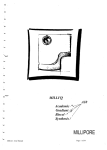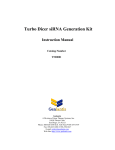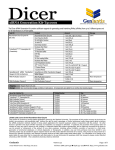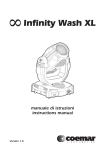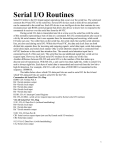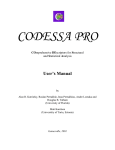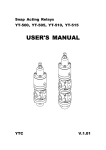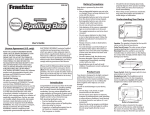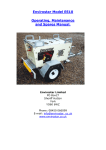Download DESIREE—A Double Electrostatic Storage Ring for
Transcript
DESIREE – A Double Electrostatic Storage Ring for Merged-Beam Experiments H. Danared*, L. Liljeby*, G. Andler*, L. Bagge*, M. Blom*, A. Källberg*, S. Leontein*, P. Löfgren*, A. Paál*, K.-G. Rensfelt*, A. Simonsson*, H. T. Schmidt†, H. Cederquist†, M. Larsson†, S. Rosén† and K. Schmidt† * Manne Siegbahn Laboratory, Frescativägen 28, S-104 05 Stockholm, Sweden Department of Physics, Stockholm Universtity, S-106 91 Stockholm, Sweden. † Abstract. DESIREE is a double electrostatic storage ring cooled to cryogenic temperatures. It is built at the Manne Siegbahn Laboratory for merged-beam and single-beam experiments in atomic and molecular physics as well as biophysics. This paper describes the present status of the design of DESIREE. Keywords: Storage rings, electrostatic rings, merged beams, ion-ion collisions PACS: 29.27.-a, 41.75.-i, 82.30.Fi INTRODUCTION Electrostatic storage rings were introduced [1] a little less than a ten years ago as a tool for studies in atomic and molecular physics and related disciplines. Since then, several other electrostatic rings have been or are being built, and yet others are being planned. At the Manne Siegbahn Laboratory, a double electrostatic storage ring, DESIREE [2], is being designed, as reported in this paper. There are several reasons for building electrostatic rather than magnetic storage rings when high particle energies are not required. Perhaps the most important factor, at least in the present case, is cost. An electrostatic bending element, such as a pair of deflection plates, is much cheaper to manufacture than a dipole magnet. It is also lighter and smaller, allowing a more compact design of the ring (or rings) as a whole. Another factor, often quoted, is that the electrical force is stronger than the magnetic force for low particle velocities, since the magnetic force is proportional to the velocity. As a result, heavy particles in low charge states can have higher velocities in electrostatic rings than in magnetic ones. Assuming electrical field strengths similar to those in the existing electrostatic rings and magnetic fields similar to those in small magnetic storage rings like CRYRING, one finds a cross-over at a mass of about 100 for singly charged ions. Heavier particles will move faster in an electrostatic ring and vice versa. Whether high particle velocities is an advantage is another issue, and the answer depends on what type of experiments one wants to perform. A third advantage is that, for an ion source on a given electrical potential, ions with all charge-to-mass ratios can be stored in an electrostatic ring without change of the CP821 Beam Cooling and Related Topics, International Workshop on Beam Cooling and Related Topic - COOL05 edited by S. Nagaitsev and R. J. Pasquinelli © 2006 American Institute of Physics 0-7354-0314-7/06/$23.00 465 voltages of the ion-optical elements. The charge-to-mass ratio used in the ring is then selected by an analyzing magnet in the injection line. The ring can thus be set up with an ion species where a high current is available, and a second species can then be stored by just changing the setting of the analyzing magnet, even if the current is too low for the available ring diagnostics. Some difficulties in building electrostatic storage rings are due to the fact that there exists less experience from such devices, and there are fewer design tools available. Also, electrostatic beam-optical elements tend to have larger aberrations than magnetic ones. DESIREE (Double ElectroStatic Ion Ring ExpEriment), see fig. 1, is a double electrostatic ring designed for experiments with merged beams of positive and negative ions. It can also be used for experiments with only one ring, such as measurement of atomic lifetimes or studies of the physical properties of biomolecules. The entire device will be cooled to a temperature of 5–8 K in order to achieve a good vacuum and allow the storage of molecular ions in their lowest vibrational and rotational states. FIGURE 1. Schematic diagram of DESIREE with the lids of the vacuum vessels removed. The fact that DESIREE will be cooled to cryogenic temperatures motivates the use of electrostatic technology, since the device then can be made sufficiently compact so that both rings can be built inside a single cryostat, as seen in the figure. DESIREE is now being designed, and construction of the main components will begin during 2006. It is expected that commissioning can start at the end of 2007. 466 TECHNICAL DESIGN Rings DESIREE consists of two rings, each one with a circumference of approximately 9.3 m. The rings have one common straight section where the beams of the two rings are merged. Both rings have 160-degree cylindrical bends and 10-degree parallel-plate deflectors. The upper ring in fig. 1 (referred to as the light-ion ring) always has a 10degree deflection at the ends of the common straight section. The lower ring (the heavy-ion ring) can have ions with different energy or charge compared to the lightion ring, and these will then deflect by an angle that is different from 10 degrees. Due to geometric constraints, the ions in the two rings must have charges with opposite sign, and the deflection angle at the end of the straight section can range between 0.5 and 10 degrees for ions in the heavy-ion ring. Additional deflectors are required in this ring to compensate for the varying deflection angle. All deflecting and bending elements have a focussing action in the horizontal plane, and, in addition, there are four quadrupole doublets in each ring and a few horizontal and vertical correction elements. Injection is made by a rapid switching of the respective 10-degree deflectors. A settling time of 1 µs is foreseen for the deflector voltage supply, which will be sufficient for the injection of H+ or H- at 100 kV. Possibly, extraction will also be implemented in a similar way. The rings are designed for a maximum energy of 100 keV times the charge state of the ion, i.e., for injection from a platform on 100 kV. In this case, the maximum voltage on the electrodes of the optical elements is 16 kV. An additional geometric constraint is due to the fact that neutral reaction products from the common straight section must be able to reach detectors located at the extension of this section, rather than being intercepted by deflection plates. It will also be possible to detect neutral particles produced on the two injection straight sections. Since both optical elements and detectors are mounted directly on the bottom of the inner vacuum vessel, as described below, it will be possible to put detectors in additional positions if there will be experiments requiring these. Vacuum and Cryogenics The two rings will be housed in a common vacuum chamber/cryostat with double walls. The outer wall or vacuum chamber will be built from 5 mm thick steel, and it will have to be reinforced by external beams to support the atmospheric pressure. Its size is approximately 4.9 m × 2.6 m × 0.7 m plus reinforcement beams which add 0.24 m on all sides. The inner chamber will be made from 5 mm aluminium, but it will have a thicker bottom on which optical elements and detectors will be mounted as mentioned below. It will have less reinforcements, and it will not be built to withstand atmospheric pressure. Between the two vessels, there will be a thermal screen and multilayer insulation between the screen and the outer vessel. The vessels will have large lids, almost as large as the vacuum vessels themselves. Feedthroughs will mainly 467 be mounted at the bottom of the vessels, such that the lids can be opened without the need to disconnect all feedthroughs. The cooling will be achieved through the use of cryogenerators. According to calculations, two cryogenerators (Sumitomo CSW71/RDK-515D) will be needed to reach the desired temperature. The first stage of the cryogenerators will be connected to the screen, and the second stage to the inner vacuum vessel. It is estimated that the heat load on the screen will be approximately 60 W, which will result in a temperature below 60 K. The inner vessel will receive a heat load of around 3 W, which should give a temperature of 5 K on the rings. If the heat loads will become bigger, it is possible to add one or two more cryogenerators. It will also be possible to run DESIREE at higher temperatures, up to room temperature. The inner vacuum vessel thus has to be bakeable to 150ºC, putting restrictions on the choice of materials, etc. It is then also necessary to have a high pumping capacity on the inner vessel. This will be achieved through titanium sublimation pumps in combination with turbo pumps, and it is expected that a pressure of 1×10-11 mbar can be reached at room temperature. At low temperatures, these pumps will remove hydrogen and helium while all other gases have negligible vapour pressure at 5 K. Fig. 2 shows results of tests of a cryogenerator of the above model. These tests were made in order to verify the specifications from the manufacturer and to measure the cooling power at higher temperatures than given in the specifications. It can be seen from the figure that the agreement between measurements and specifications is very good in the range where specifications exist. FIGURE 2. Measurements of temperatures on the first and second stage of a Sumitomo CSW71/RDK515D cryogenerator when a heat load is applied to the second stage. The curves show measurements and the filled circles represent specifications. An efficient heat transfer from all components seen by the beams to the cryogenerators is important in order to get reasonably short cooldown times and low final temperatures. For this reason, and also for the sake of mechanical stability, the 468 bottom of the inner vacuum vessel will be made from 12 mm thick aluminium, and the beam-optical elements, detectors, etc., will be mounted directly on this aluminium plate. Flexible copper braids will connect this plate to the cryogenerator heads. Tests have indicated that a temperature difference between the aluminium plate and the cryogenerator head lower than 1 K can be obtained. Injectors DESIREE will be provided with at least two injectors, one for each ring, although both injectors will be able to supply ions to both rings. The injectors consist of a highvoltage platform, an ion source and an analyzing magnet. The injector mainly supplying the heavy-ion ring will be tailored to heavier ions in that it will be built for a higher platform voltage, 100 kV, and it will have a larger magnet with higher resolving power. The magnet itself, with a bending power of 1.9 Tm, will be on earth potential, but the vacuum chamber will be insulated for 100 kV. The injector mainly used for the light-ion ring will have a 25 kV platform voltage. Several kinds of ion sources are foreseen, such as a standard plasmatron (‘Nielsen’ type) source for singly charged atomic and molecular ions, an expansion source for molecules in low rotational states, an electron-impact source producing molecules in known vibrational states, a sputter ion source for negative ions, an electrospray source for complex molecules and biomolecules, and possibly an ECR ion source for multiply charged ions. The use of a cooled ion trap after the electrospray source is being investigated. With such a trap the ions can be accumulated and buffer-gas cooled in order to increase the particle intensity in the beam pulse and to decrease the beam emittance. ION OPTICS The light-ion ring has two symmetry planes, and if the voltages on the ion-optical elements are to obey that symmetry, the optics is defined by only two parameters: the focusing and defocusing quadrupole voltages. Using standard linear transfer matrices for ideal quadrupoles and cylindrical deflectors, and approximating the parallel-plate deflectors also with cylindrical deflectors, a stability diagram like the one in fig. 3 is obtained simply from matrix multiplication and standard procedures for calculating the stability criterion and Q values. It is seen that the stable islands are relatively small, but that it is possible to find several working points with, e.g., round well-focused beams in the common straight section. The smallness of the islands is related to the rather long straight sections without focusing, which is an inevitable consequence of the merged-beams design. The existence of stable orbits was initially proven using COSY INFINITY [3], and later on also with SIMION [4]. The latter code evaluates the electric fields numerically and in this sense gives more realistic results, at the expense of much longer execution times, so that much less detail can be obtained. The results from both the COSY INFINITY and SIMION calculations agree well with those from the simple matrix multiplications discussed here. 469 FIGURE 3. The left part of the figure shows stable islands for the light-ion ring as a function of the horizontal and vertical quadrupole strengths (where the strength multiplied by the 0.10 m electrode length is the inverse of the focal length for a single quadrupole). The right part shows the Q values corresponding to the islands to the left, and the upper right Q diagram corresponds to the upper right islands and vice versa. The colours are such that red represents round beams on the common straight section while blue and violet represent flat beams. Saturated colours represent small, well-focused beams in the common straight section while unsaturated colours represent unfocused beams. The heavy-ion ring has four more parallel-plate deflectors, which are required in order to merge ions with different charge-to-mass ratios or energies with the ions stored in the other ring. As a result, the heavy-ion ring only has one symmetry plane, and, since the amount of deflection depends on the charge-to-mass ratios in the two rings (or, in the general case of different ion velocities, on the ratio of particle energy per unit charge in the two rings), the optics and the lattice functions will depend on this ratio. More specifically, the three deflectors on each side of the common straight section will contribute to focusing in the horizontal plane, such that a larger deflection angle gives stronger focusing. The stable islands for the heavy-ion ring will thus be larger if the deflection in the deflectors closest to the common straight section is large, which is the case when the energy per unit charge is the same in both rings. Aberrations tend to be larger with electrostatic optics than with magnets. For instance, an electrostatic quadrupole gets aberrations of octupole character because the particles change speed in the electrical fields. Such aberrations can limit the dynamic aperture of an electrostatic ring, as illustrated in fig. 4. Here, particles were traced through the same lattice as used for the calculations of fig. 3, but the octupole effect of the quadrupoles were taken into account in a simple approximation. Particles were traced up to 100 turns through light-ion ring with the same parameters as were used for fig. 3, except that the range of focusing strengths is smaller. The largest, purple areas represent k and Q values where particles with an emittance of 0.1 mm mrad in each plane survive 100 turns. Blue and green indicate larger emittances, and red shows k and Q values where particles with an emittance of 100 mm mrad survive at least 100 turns. 470 FIGURE 4. The different colours show k and Q values where particles with different emittances survive at least 100 turns in the light-ion ring. Purple indicates survival of particles with 0.1 mm mrad, and the emittance increases in steps of 10 mm mrad up to 100.1 mm mrad which is indicated with red. Fig. 4 is not an exact representation of the dynamic aperture in DESIREE since aberrations in the deflecting elements are not included, nor higher-order effects in the quadrupoles. Also, fringe fields are not included. A complete result again requires a more realistic evaluation of the fields, using a code like SIMION. Such calculations have been performed for DESIREE, although a map as detailed in fig. 4 would be far too time-consuming to produce using such a technique. APPLICATIONS As mentioned above several plans exist for the use of DESIREE in single-ring configuration for lifetime measurements and interactions with laser fields ranging from high-precision spectroscopy with continuous wave lasers to experiments involving ultra-short pulses in the fs range. However, as the single most original feature of DESIREE is the possibility to investigate interactions between positive and negative ions at low relative velocity, we will focus on this aspect here. The process of mutual neutralization (MN) between two singly charged – one positive and one negative – ions to form two neutral products is an ideal case for DESIREE. The neutral products will continue straight in the field where the two ion beams are separated and can readily be detected. By applying a detector with multihit capability and position sensitivity it is even possible to determine the amount of kinetic energy released in the process. Another advantage of such a scheme will be the direct detection of more than two neutral fragments in coincidence. This is of importance when molecular ions are taking part in the collisions and the question of whether the electron transfer is accompanied by dissociation is addressed. The study of molecular ions will further benefit from one of the other advanced DESIREE features namely the very low temperature, which in turn leads to very good vacuum and presumably thereby also very long storage lifetimes. This combination means that 471 infrared-active ions will be found to reach internal temperatures of similarly low values, thus resulting in population of only one or a few quantum states. The interest in the MN process is both in the fundamental mechanisms and in total cross section determinations for related fields such as the chemistry of interstellar clouds and in planetary atmospheres (including our own). As an example of the fundamental interest we mention the fact that it is a matter of current debate whether or not the neutral hydrogen molecule formed in the MN of H- with H2+ (or HD+) will dissociate [5]. An even simpler system to consider is the p-H- system. Here the obvious objection to performing such an experiment in DESIREE would be that no use is made of the low temperatures and the beam storage. This is, however, exactly the point. In the near future we will engage in an effort to measure this process in a single-pass merged-beams experiment lead by Prof. Urbain of the Catholique University of Louvain-la-Neuve in Belgium. The later repetition of the exact same experiment in DESIREE is expected to provide very useful calibration information needed for the determination of absolute cross sections for mutual neutralization and other merged-beams experiments involving molecular ions. REFERENCES 1. S. P. Møller, Nucl. Instr. Meth. A 394, 281 (1997). 2. K.-G. Rensfelt et al., in Proc. EPAC 2004, edited by J. Poole, J. Chrin, Ch. Petit-Jean-Genaz, C. Prior and H.A. Synal, Lucerne 2004, p. 1425. 3. M. Berz, COSY INFINTY Version 8.1 User’s Guide and Reference Manual, Michigan State Univ. 2002. 4. D. A. Dahl, SIMION 3D Version 7.0 User’s Manual, INEEL, Idaho Falls, USA. 5. M. J. J. Eerden et al., Phys. Rev. A 51, 3362 (1995). 472









